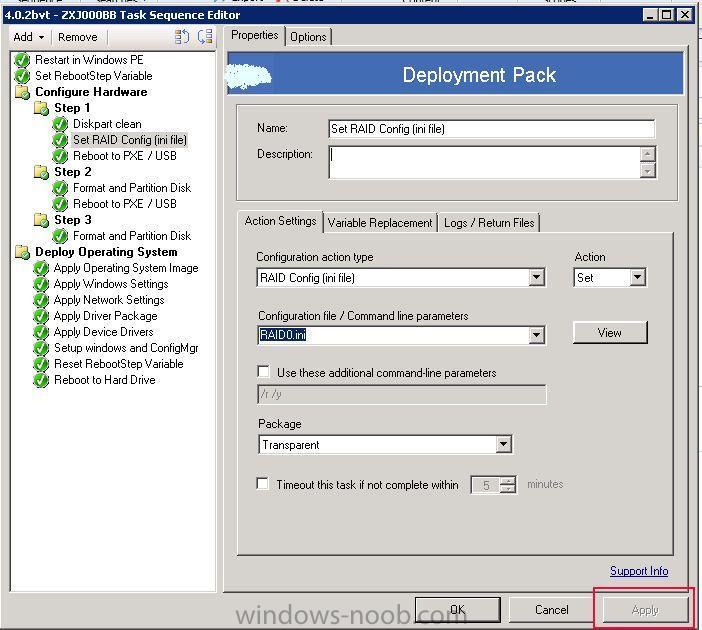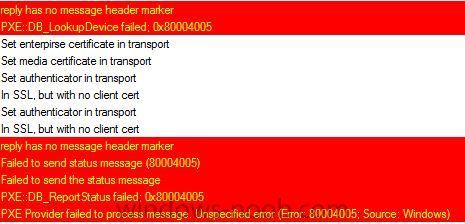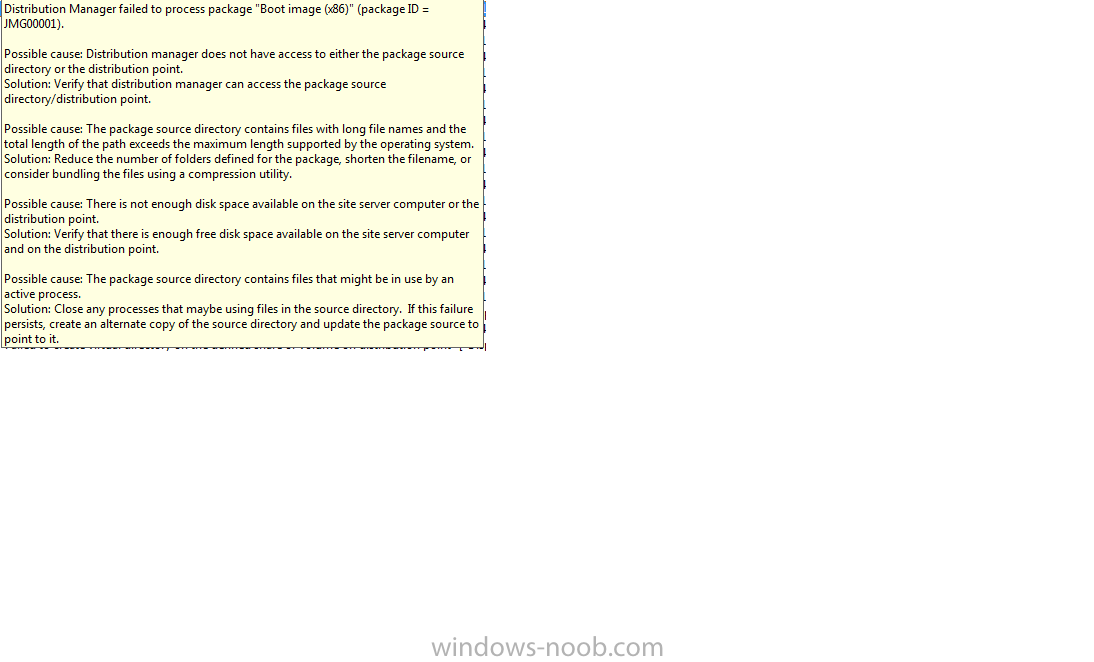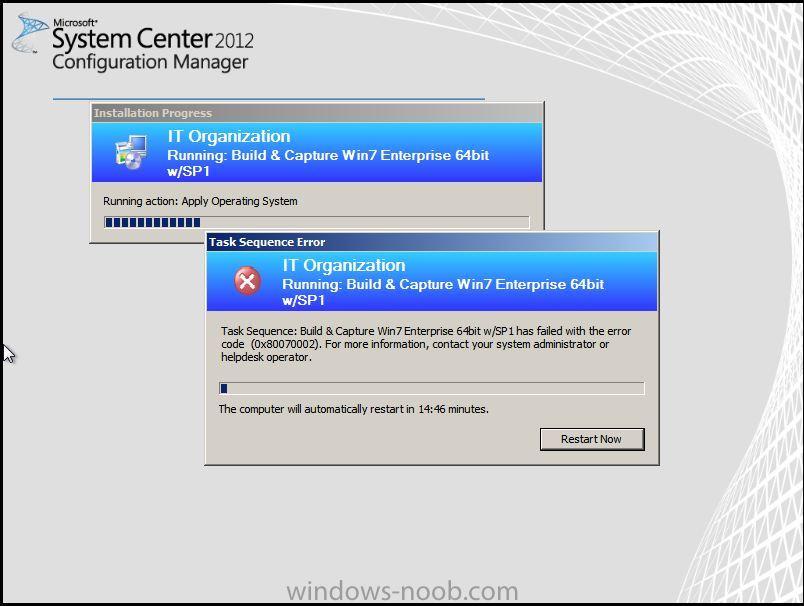Search the Community
Showing results for tags 'osd'.
-
Hello everyone , Some time ago we released console extensions for computer autonaming with desired prefix. Based on feedback we have received we are happy to announce that version 2.0 of our console extensions is available. Detailed information can be found on our website For those who would like to use that style of computer autonaming - but necessarly extend console of SCCM you can use our webservices - detailed information here Sorry we didn't make for Xmas but we are still hoping you will find this a great extension to power of SCCM Thanks Rafal
-
- OSDComputerName
- Autonaming
-
(and 4 more)
Tagged with:
-
Hei all, I am having a truly strange experience with our SCCM2012 server and a OSD to some desktops. Now, if I had just started with them I would have thought that I had the incorrect driver, but thats not the case here. About a month back I started to configure replacement client desktops for the students. These machines would be going to the library, an intense environment for data. So to make things simple for myself, I took some old HP dx2250 Athlon pc's, installed a new PCI Wifi card and imaged them from SCCM with Win7 x32. I have completed all of them, no problem. I then decided to expand on the usable machines and place several more in the common areas. First batch went well. But the second batch hit a hitch. When they were loading the WinPE environment, they repeatedly rebooted when the network drivers were been loaded. The machines are IDENTICAL in every way to the ones that had been imaged before. I tried booting them on different vlans, but the same issue happened on all. Finally I took one of them over to my work office to troubleshoot it and low and behold - it worked. I did no changes, just booted it from a different physical location. The vlans here are the same as in their previous location. And now things go really weird. I brought over the last 3 and two of them did the same as the first. But not the last. No matter what I try, I cannot get the WinPE environment to load past the network driver load. As mentioned before, the machine is identical to all the others that have been successful. Are there any logs that I can check to follow up or do any of you have any tips for me? Cheers & thanks in advance! Anthony
-
Hi Guys, I am in the middle of planning an sccm design and have hit a crossroads. Basically we have 2 larger sites ( one with more kit than the other ) and 1 smaller site connected to each. my first question is, should I use primary and secondary sites or should I use cas, primary and secondary. OR should I use primary and DP's etc. all sites have aprox 1000 users and 100mb site links. the other thing I was unsure of is how to make sure that if one site is offline can the other site still do osd ?? do I need to add MP's to achieve this or ?? thanks
-
First, thank you all for putting together such a complete forum on SCCM and related topics as they have been essential in my daily duties. We are attempting to deploy custom normal.dotm, blank.potx, and normalemail.dotm files which are configured for Verdana font. So far, the following items have been completed: 1. Created customized W7 Image on VMWare 2. Installed Office 2010 SP1 with custom (normal.dotm, blank.potx, normalemail.dotm) located at c:\users\%username%\appdata\microsoft\templates 3. Ran Sysprep by running following .CMD <C:\windows\system32\sysprep\sysprep.exe /oobe /shutdown /generalize /unattend:C:\windows\system32\sysprep\unattend.xml> 4. Captured .wim using ImageX 5. Deploying OSD via SCCM 2012 All customizations are deployed properly to all users who login except for the Office Template files (CopyProfile=True in unattended.xml). The path c:\users\%username%\appdata\microsoft\temlates is not copied to each user who logs in. To rectify this, we added a RunOnce registry entry on our Reference Machine to create the path and copy the necessary files. We thought this was the fix, but once Word is launched for the first time it renames the normal.dotm file to .old. Microsoft has published the following article to address this issue (http://support.microsoft.com/kb/2408845) which does work on a per user basis. However, we need to ensure this registry entry is present for any user who logs into the computer. At this point, we have tried also using the RunOnce function to import the reg key ("HKCU\Software\Microsoft\Office\14.0\Word\Options\MigrateNormalOnFirstBoot", 1, "REG_DWORD") but this has not worked in adding the Reg entry for each user. Can we get some guidance on how to best deploy custom normal.dotm, blank.potx, and normalemail.dotm during OSD with SCCM 2012. Thank you all!
- 6 replies
-
- normal.dotm
- OSD
-
(and 3 more)
Tagged with:
-
So here's the deal...when PXE booting a workstation it displays the MAC and the SMS BIOS GUID-- which I've used before to import a workstation, though usually we just boot workstations as Unknown and deploy an OS through the Unknown Computers collection--but when trying to image this one particular workstation, we noted that it simply kept restarting itself after running the pre-execution hook. Taking a look at the logs revealed that when it begins the identity request, that it is logging a different SMS BIOS GUID than what is displayed when we first PXE boot. This then resolves to a different NetBIOS name (even though the MAC address is logged correctly), which is how I first noticed that the SMS BIOS GUID was wrong. For example, what is seen in SMSTS.log: Preparing Client Identity Request. TSPxe 9/10/2012 2:50:33 PM 1220 (0x04C4) Setting transport. TSPxe 9/10/2012 2:50:33 PM 1220 (0x04C4) Setting SourceID = d25404f6-c37b-4ee8-91c0-c0b6aeaa4cf4. TSPxe 9/10/2012 2:50:33 PM 1220 (0x04C4) Setting site code = ###. TSPxe 9/10/2012 2:50:33 PM 1220 (0x04C4) Setting SMBIOS GUID = 4C4C4544-0000-2010-8020-80C04F202020. TSPxe 9/10/2012 2:50:33 PM 1220 (0x04C4) Adding MAC Address 00:19:B9:24:65:5A. TSPxe 9/10/2012 2:50:33 PM 1220 (0x04C4) So here are how the SMS BIOS GUID's are being reported for the same workstation: 4C4C4544-0000-2010-8020-80C04F202020 <-- SMSTS log file 44454C4C-0000-1020-8020-80C04F202020 <-- pxe boot initialization You can note that they are nearly identical, with the first and third sections pretty much being the reverse of each other. All of my site system and component statuses are fine...no errors there (with the exception of an AD discovery error). On top of this, we had a workstation accidentally get imaged a couple weeks ago due to a duplicate reported MAC address. Interestingly enough, if you checked the MAC address on the workstation then it would give you the correct information, but the DDR client properties in SCCM listed the incorrect MAC. I ran the duplicate MAC address report and found a couple entries listed, and just ended up deleting them at the time (figuring that they would get added back with their correct MAC's, which they have thus far). The issue in this case though is that the client wasn't reporting the correct value back to SCCM (which was obviously not duplicated based on ipconfig /all command from the "supposedly" conflicting workstations)...which is similar to what's happening here with the PXE booting and the SMS BIOS GUID. So all that being said, has anyone else run into this problem or have any ideas on a solution? Please let me know if I can provide further information! Thanks!
-
First, thank you all for putting together such a complete forum on SCCM and related topics as they have been essential in my daily duties. We are attempting to deploy custom normal.dotm, blank.potx, and normalemail.dotm files which are configured for Verdana font. So far, the following items have been completed: 1. Created customized W7 Image on VMWare 2. Installed Office 2010 SP1 with custom (normal.dotm, blank.potx, normalemail.dotm) located at c:\users\%username%\appdata\microsoft\templates 3. Ran Sysprep by running following .CMD <C:\windows\system32\sysprep\sysprep.exe /oobe /shutdown /generalize /unattend:C:\windows\system32\sysprep\unattend.xml> 4. Captured .wim using ImageX 5. Deploying OSD via SCCM 2012 All customizations are deployed properly to all users who login except for the Office Template files (CopyProfile=True in unattended.xml). The path c:\users\%username%\appdata\microsoft\temlates is not copied to each user who logs in. To rectify this, we added a RunOnce registry entry on our Reference Machine to create the path and copy the necessary files. We thought this was the fix, but once Word is launched for the first time it renames the normal.dotm file to .old. Microsoft has published the following article to address this issue (http://support.microsoft.com/kb/2408845) which does work on a per user basis. However, we need to ensure this registry entry is present for any user who logs into the computer. At this point, we have tried also using the RunOnce function to import the reg key ("HKCU\Software\Microsoft\Office\14.0\Word\Options\MigrateNormalOnFirstBoot", 1, "REG_DWORD") but this has not worked in adding the Reg entry for each user. Can we get some guidance on how to best deploy custom normal.dotm, blank.potx, and normalemail.dotm during OSD with SCCM 2012. Thank you all!
- 2 replies
-
- normal.dotm
- osd
-
(and 3 more)
Tagged with:
-
Hello everyone , I wanted to share here <hope this is the good forum to do so> my work for community. For the last 2 years I have been trying to perfect operating system deployment with SCCM and automate it as much as possible. However with the requirements of my clients I had to come up with really customized solutions. At the beginning I have developed webservices. But considering changes/pckages updates etc that was not really the way I wanted to finish. this challenged me to create custom SCCM console extension to include RIS style naming (a bit more than just that ) It is available for everyone under my codeplex page http://itxsolutions.codeplex.com I hope you would find it usefull - your feedback / input will be much appreciated
-
So I am trying to deploy Windows 7 with BitLocker to a laptop. I'm following the steps in http://www.windows-n...oyments-part-5/. I cannot for the life of me get this thing to encrypt the hard drive. It runs through everything and at the end after the final reboot I get the following message: No matter which I choose I end up with an unencrypted drive. Attached is my bitlocker log. Says it completed successfully. I went into the control panel and manually turned on BitLocker. I received the message above however when i presses F10 it went through and asked me some questions. Where to save recovery key etc, and then started the encryption. Not sure why SCCM can't seem to get the encryption going. Any insight would be much appreciated. bitlocker.txt
-
Hi all, Whenever I try to perform OSD through network, the following steps happen: Client machines gets an IP and boot image gets downloaded. Task seqences shows up, and I choose any task sequence. As soon as I choose a Task Sequence and it tries to confirm the location of applications in Task sequences, it fails to do so. Below is the snapshot of the smsts.log file: PackageID = 'CNT001AB' InstallSoftware 11/1/2012 7:46:47 PM 1484 (0x05CC) BaseVar = '', Continueonerror='' InstallSoftware 11/1/2012 7:46:47 PM 1484 (0x05CC) SwdAction = '0001' InstallSoftware 11/1/2012 7:46:47 PM 1484 (0x05CC) DownloadOnDemand flag is true. Attempting to download content locally for Package CNT001AB.. InstallSoftware 11/1/2012 7:46:47 PM 1484 (0x05CC) nPos != String::npos, HRESULT=800700a1 (e:\nts_sms_fre\sms\framework\core\ccmcore\path.cpp,99) InstallSoftware 11/1/2012 7:46:47 PM 1484 (0x05CC) RecursiveCreatePath(sPath.substr(0, nPos), psa), HRESULT=800700a1 (e:\nts_sms_fre\sms\framework\core\ccmcore\path.cpp,102) InstallSoftware 11/1/2012 7:46:47 PM 1484 (0x05CC) RecursiveCreatePath(sPath.substr(0, nPos), psa), HRESULT=800700a1 (e:\nts_sms_fre\sms\framework\core\ccmcore\path.cpp,102) InstallSoftware 11/1/2012 7:46:47 PM 1484 (0x05CC) RecursiveCreatePath( sNormalizedPath, psa ), HRESULT=800700a1 (e:\nts_sms_fre\sms\framework\core\ccmcore\path.cpp,157) InstallSoftware 11/1/2012 7:46:47 PM 1484 (0x05CC) DownloadContentLocally(pszSource, sSourceDirectory, dwFlags, hUserToken, pszUserName, pszUserPassword), HRESULT=800700a1 (e:\nts_sms_fre\sms\framework\tscore\resolvesource.cpp,3130) InstallSoftware 11/1/2012 7:46:47 PM 1484 (0x05CC) TS::Utility::ResolveSource(pszPkgID, sPath, 0, hUserToken, sUserName.empty() ? NULL : sUserName.c_str(), sUserName.empty() ? NULL : sUserPassword.c_str()), HRESULT=800700a1 (e:\nts_sms_fre\sms\client\osdeployment\installsoftware\runcommandline.cpp,395) InstallSoftware 11/1/2012 7:46:47 PM 1484 (0x05CC) Failed to resolve the source for SMS PKGID=CNT001AB, hr=0x800700a1 InstallSoftware 11/1/2012 7:46:47 PM 1484 (0x05CC) cmd.Execute(pszPkgID, sProgramName, dwCmdLineExitCode), HRESULT=800700a1 (e:\nts_sms_fre\sms\client\osdeployment\installsoftware\main.cpp,385) InstallSoftware 11/1/2012 7:46:47 PM 1484 (0x05CC) Install Software failed to run command line, hr=0x800700a1 InstallSoftware 11/1/2012 7:46:47 PM 1484 (0x05CC) Process completed with exit code 2147942561 TSManager 11/1/2012 7:46:47 PM 1400 (0x0578) I have feeling that machine is not able to get machine policy , as a result not able to locate the desired package. Please help...Its really urgent. Thanks in advance
-
Hi everyone, I know it's possible but I don't know how to do that and I don't find the answer or my keyword search is not good... So I create a bootable ISO with a TSequence media wizard using bootable media... the way to deploy wim across the network. But now I want to put the Wim file on my ISO boot file (on a usb key after...) and modify the TS to get the wim directly on the ISO and not on the network.... how can I do that ?? I'm on SCCM SP2 R3 and try to deploy Windows 7 x64. It works fine on a network but with the wim file on the key I can optimize time to create workstation... Thank's for help !! Slash
-
Hi All, Please help me out here guys. The issue is,, there is a site where when machine is started for OSD thriugh network. It picks-up IP, Contacts DHCP easily but after that gets "TFTP Time Out Error". It means boot image is not downloaded and further process is not processed. However, on PXE server, in SMSPXE.log a hit is generated where I can see the error as: MAC=00:25:11:07:3F:E5 SMBIOS GUID=FEFEFEFE-FEFE-FEFE-FEFE-FEFEFEFEFEFE > Device found in the database. MacCount=1 GuidCount=239 smspxe 10/22/2012 11:01:15 AM 2040 (0x07F8) [010.033.001.014:67] Recv From:[000.000.000.000:68] Len:548 7aa004 smspxe 10/22/2012 11:01:17 AM 1740 (0x06CC) Ignoring req from [000.000.000.000:68] Dest Server:[010.033.001.007] smspxe 10/22/2012 11:01:17 AM 1740 (0x06CC) [010.033.001.014:4011] Recv From:[010.033.001.105:68] Len:548 24fd544 smspxe 10/22/2012 11:01:17 AM 1744 (0x06D0) [010.033.001.014:4011] Recv From:[010.033.001.105:68] Len:303 801aec smspxe 10/22/2012 11:01:17 AM 1744 (0x06D0) Executing GetBootAction(29051, MUM-HCLC-SEC02) smspxe 10/22/2012 11:01:17 AM 2040 (0x07F8) No Boot Action for Device (29051) found smspxe 10/22/2012 11:01:17 AM 2040 (0x07F8) My concern is that, as per the log above, the request from client is receiving at DHCP server, but still it is not able to proceed ahead and download boot image + other process that follows. Please help me out!!!!!!!!!!!!!!!!!!! Thanks in advance
-
We face an issue when do the OSD OEM integration with SCCM 2012 SP1 beta. In task sequence editor, we add our customized step action control, and follow the step as MSDN indicated:http://msdn.microsoft.com/en-us/library/cc143499.aspx . We want to active the "apply" button in task sequence editor by using the API SetDirtyFlag(true) or Dirty = true when things changed in our action control. However, "apply" button is not enabled after call this method. We use the same logic to perform this task, and no issues happened on SCCM 2007 R2 or SCCM2012. SCCM2012SP1beta has this kind of issue, but SCCM2007R2/2012 don't. Env: windows2008r2 + SCCM2012SP1 beta Steps to Reproduce: (steps could be found on MSDN http://msdn.microsoft.com/en-us/library/cc143499.aspx ) 1. find the required dll under C:\Program Files (x86)\Microsoft Configuration Manager\AdminConsole\bin on SCCM2012SP beta server, and reference these assemblies in my own project ---assemblies list---- AdminUI.Common.dll AdminUI.DialogFoundation.dll AdminUI.OsdCommon.dll AdminUI.TaskSequenceEditor.dll AdminUI.WqlQueryEngine.dll Microsoft.ConfigurationManagement.ApplicationManagement.dll Microsoft.ConfigurationManagement.ApplicationManagement.Extender.dll Microsoft.ConfigurationManagement.DialogFramework.dll Microsoft.ConfigurationManagement.exe Microsoft.ConfigurationManagement.exe.config Microsoft.ConfigurationManagement.ManagementProvider.dll ------------------------ 2. add event handler to my customized action control, e.g. for a text field, add an event handler once content changed. In the handler, set dirty flag by leverage the API "Microsoft.ConfigurationManagement.AdminConsole.SmsPageControl.SetDirtyFlag(bool" to active the "apply" button as we always do. Since this method is deprecated in SP1 dll, we also try set "Dirty" property to "true" as indicated. However, neither of them succeed to enable the "apply" button ---code--- SetDirtyFlag(true); //Dirty = true; 3. however the "apply" button doesn't active at all. if we click "ok" button, the changes doesn't save either. the user will not be able to save the any changes in my customized action control. It will be very annoying. So it is a must fix defect.
-
- sccm2012 sp1
- osd
-
(and 2 more)
Tagged with:
-
I am having issues with my Task Sequence for deploying Windows 7 Ultimate to out Lenovo Laptops. The TS used has been working successfully; however, this is now failing with an error code of 0x80004005. Within the smsts.log, there are a number of error & warning lines, so I'm not sure exactly what the root cause of this failure is, however, near the beginning of the logfile, there is the following entry: Found network adapter "1x1 11b/g/n Wireless LAN PCI Express Half Mini Card Adapter" with IP Address 0.0.0.0. I am wondering if this is what is ultimately causing the TS to fail; the main NIC card is an Intel® 82579LM Gigabit Network card, connected via cable. Is this likely to be the root cause of the TS failure? Is there a way to "force" the TS to use the 82579LM card? smsts.log file attached Stan smsts-20121017-160511.log
-
Here is the error in my smsts.log (attached) <![LOG[Error. Received 0x80072ee7 from WinHttpSendRequest.]LOG]!><time="17:01:44.656+300" date="10-09-2012" component="InstallApplication" context="" type="1" thread="3240" file="libsmsmessaging.cpp:8689"> <![LOG[unknown host (gethostbyname failed)]LOG]!><time="17:01:44.656+300" date="10-09-2012" component="InstallApplication" context="" type="3" thread="3240" file="libsmsmessaging.cpp:692"> When PE first boots up and starts installing the OS I have an IP address. It then reboots, and the apply network settings task runs outside of PE, it reboots again, and goes back into PE for the Apply Drivers tasks. I hit f8 on this PE window and I have NO ip address or anything. Ipconfig shows it as it would without any drivers. There is this error previous to the one above. But I'm not sure if its related. <![LOG[Error getting system isolation info. Code 8027000C]LOG]!><time="17:00:14.234+300" date="10-09-2012" component="TSManager" context="" type="3" thread="2132" file="remediate.cpp:632"> <![LOG[ComputeComplianceAndRemediate(&QState), HRESULT=8027000c (e:\nts_sccm_release\sms\client\tasksequence\napcontrol\tsnapcontrol.cpp,48)]LOG]!><time="17:00:14.234+300" date="10-09-2012" component="TSManager" context="" type="0" thread="2132" file="tsnapcontrol.cpp:48"> <![LOG[Remediation failed. Code 8027000C]LOG]!><time="17:00:14.234+300" date="10-09-2012" component="TSManager" context="" type="3" thread="2132" file="tsnapcontrol.cpp:48"> <![LOG[hr = m_oNapCtrl.Remediate(QState), HRESULT=8027000c (e:\nts_sccm_release\sms\client\tasksequence\tsmanager\tsmanager.cpp,1364)]LOG]!><time="17:00:14.234+300" date="10-09-2012" component="TSManager" context="" type="0" thread="2132" file="tsmanager.cpp:1364"> <![LOG[Remediation failed with error code 8027000C]LOG]!><time="17:00:14.234+300" date="10-09-2012" component="TSManager" context="" type="3" thread="2132" file="tsmanager.cpp:1364"> Thanks for the help! smsts-20121010-103553.log
- 4 replies
-
- sccm2012
- configmgr2012
-
(and 3 more)
Tagged with:
-
When i try to pxe boot a client, i only get PXE-E53 "No boot filename received" I have tried to reinstall wds/pxe several times.. searched trough a lot of post with similar problems..tried lot of solutions.. but still stuck.. I really dont know where to begin to troubleshoot this.. SMSPXE: reply has no message header marker SMSPXE 27.04.2012 12:36:19 3936 (0x0F60) PXE::DB_LookupDevice failed; 0x80004005 SMSPXE 27.04.2012 12:36:19 3936 (0x0F60) Set enterpirse certificate in transport SMSPXE 27.04.2012 12:36:19 3936 (0x0F60) Set media certificate in transport SMSPXE 27.04.2012 12:36:19 3936 (0x0F60) Set authenticator in transport SMSPXE 27.04.2012 12:36:19 3936 (0x0F60) In SSL, but with no client cert SMSPXE 27.04.2012 12:36:19 3936 (0x0F60) Set authenticator in transport SMSPXE 27.04.2012 12:36:19 3936 (0x0F60) In SSL, but with no client cert SMSPXE 27.04.2012 12:36:19 3936 (0x0F60) reply has no message header marker SMSPXE 27.04.2012 12:36:19 3936 (0x0F60) Failed to send status message (80004005) SMSPXE 27.04.2012 12:36:19 3936 (0x0F60) Failed to send the status message SMSPXE 27.04.2012 12:36:19 3936 (0x0F60) PXE::DB_ReportStatus failed; 0x80004005 SMSPXE 27.04.2012 12:36:19 3936 (0x0F60) PXE Provider failed to process message. Unspecified error (Error: 80004005; Source: Windows) SMSPXE 27.04.2012 12:36:19 3936 (0x0F60) Edit: also tried to add option 66/67 in dhcp.. i get past the pxe boot.. but recieve a \boot\bcd error And the same lines of errors in SMSPXE
- 26 replies
-
Hi, I have recently installed the HP SCCM integration which is provided by HP to help automate the HP proliant server deployment process, it allows for RAID, BIOS, ILO and post OS install config which is great (after some scripting) I managed to get the base template task sequence to install - using default settings but I had a few questions as its not fully litetouch the task sequence is set to use the SetReboot variable and this increments each time the machine reboot within the task sequence - the problem is, after each reboot I am presented with the following (which is annoying as I want to hit F12 and just walk away pretty much) select boot image (even thought only 1 image is in the options list) - I dont want to see this screen, shouldnt it just boot directly into the boot image and start the task sequence at every reboot that boots into PXE, I have to hit F12, shouldnt It just boot into PXE automatically and continue the task sequence? becuase I have to hit F12 each time, I also have to enter the password and select the task sequence from the list? 2.if I try and add additioanl steps to the TS - I am presented with an error which says "there are too many steps in the task sequence"?????
-
- HP Servers
- Proliant
-
(and 1 more)
Tagged with:
-
This might sound like a silly question but my knowledge of task sequences isnt that great. I need to deploy windows 7 with office 2010. One department is supposed to get Office 2010 standard whilst others need to get Office 2010 Professional Pro. Ofice 2010 needs to be included in the reference image. Will i need to create two images to cater for the two versions of office and as a result create two task sequences for the deployment?
-
Hi all, I want to share a issue I've been faced with in our sccm infrastructure, for which I hope someone has a solution. I've tried to setup a operating System Deployment Task sequence, using pxe, but unfortunately I've hit a snag. Once distributing the Boot images to the Distribution point, it just says in progress, and nothing hapens, although I have set it to automatically distribute. I'm picking up the following issue when doing a CMtrace on the smsprov.log file ( This issue shows on each reattempt) : I'm also getting the following message in status message viewer, however I have given full access to "Everyone" to the directories. I have not set "Enable unknown computer support" , as I usually import my computer by Mac adress, and then assign it to he collection where the "Advertisement/deployment" applies. Is this maybe what is causing my issues, and what are the implications of activating this? Thank you in advance.
-
I've been trying to capture a machine and have had no luck with this one. It gets almost done with the capturing of the volume then gives me an error. Here is the relevant part of smsts.log <![LOG[Capturing D:\, volume 2 of 2]LOG]!><time="11:33:55.210+480" date="08-20-2012" component="CaptureSystemImage" context="" type="1" thread="1900" file="capturesystemimage.cpp:746"> <![LOG[Capturing volume D:]LOG]!><time="11:33:55.210+480" date="08-20-2012" component="CaptureSystemImage" context="" type="1" thread="1900" file="wimfile.cpp:437"> <![LOG[ Skipping \hiberfil.sys]LOG]!><time="11:35:42.413+480" date="08-20-2012" component="CaptureSystemImage" context="" type="1" thread="1900" file="wimstate.cpp:475"> <![LOG[ Skipping \pagefile.sys]LOG]!><time="11:35:44.862+480" date="08-20-2012" component="CaptureSystemImage" context="" type="1" thread="1900" file="wimstate.cpp:475"> <![LOG[ Skipping \SMSTSLog]LOG]!><time="11:45:46.539+480" date="08-20-2012" component="CaptureSystemImage" context="" type="1" thread="1900" file="wimstate.cpp:475"> <![LOG[ Skipping \System Volume Information]LOG]!><time="11:45:54.854+480" date="08-20-2012" component="CaptureSystemImage" context="" type="1" thread="1900" file="wimstate.cpp:475"> <![LOG[ Skipping \Windows\CSC]LOG]!><time="11:47:07.362+480" date="08-20-2012" component="CaptureSystemImage" context="" type="1" thread="1900" file="wimstate.cpp:475"> <![LOG[ Skipping D:\_SMSTaskSequence]LOG]!><time="11:53:07.114+480" date="08-20-2012" component="CaptureSystemImage" context="" type="1" thread="1900" file="wimstate.cpp:468"> <![LOG[WIM has entered capture phase for 215349 items]LOG]!><time="11:53:07.114+480" date="08-20-2012" component="CaptureSystemImage" context="" type="1" thread="1900" file="wimstate.cpp:385"> <![LOG[WIM error:D:\Windows\Installer\1453ed58.msi. Data error (cyclic redundancy check). (Error: 80070017; Source: Windows)]LOG]!><time="13:35:18.522+480" date="08-20-2012" component="CaptureSystemImage" context="" type="3" thread="1900" file="wimstate.cpp:193"> <![LOG[hVolumeImage = WIMCaptureImage( m_hImageFile, const_cast<LPWSTR>(pathTargetVolume.c_str()), WIM_FLAG_VERIFY ), HRESULT=80070017 (e:\nts_sccm_release\sms\framework\tscore\wimfile.cpp,475)]LOG]!><time="13:35:22.766+480" date="08-20-2012" component="CaptureSystemImage" context="" type="0" thread="1900" file="wimfile.cpp:475"> <![LOG[unable to capture the volume image (0x80070017)]LOG]!><time="13:35:22.766+480" date="08-20-2012" component="CaptureSystemImage" context="" type="3" thread="1900" file="wimfile.cpp:475"> <![LOG[imageFile.CaptureVolumeImage( (*itr), &saFilesToNotCapture), HRESULT=80070017 (e:\nts_sccm_release\sms\client\osdeployment\capturesystemimage\capturesystemimage.cpp,747)]LOG]!><time="13:35:22.766+480" date="08-20-2012" component="CaptureSystemImage" context="" type="0" thread="1900" file="capturesystemimage.cpp:747"> <![LOG[CaptureSystemImage( progressUi, slVolumesToCapture, sOfflineSystemRoot, ImageFile), HRESULT=80070017 (e:\nts_sccm_release\sms\client\osdeployment\capturesystemimage\capturesystemimage.cpp,908)]LOG]!><time="13:35:22.766+480" date="08-20-2012" component="CaptureSystemImage" context="" type="0" thread="1900" file="capturesystemimage.cpp:908"> <![LOG[Failed to capture system image. Data error (cyclic redundancy check). (Error: 80070017; Source: Windows)]LOG]!><time="13:35:22.766+480" date="08-20-2012" component="CaptureSystemImage" context="" type="3" thread="1900" file="capturesystemimage.cpp:908"> <![LOG[Closing image file \\tech-sccmdist-1\sources\project.wim]LOG]!><time="13:35:22.766+480" date="08-20-2012" component="CaptureSystemImage" context="" type="1" thread="1900" file="wimfile.cpp:358"> <![LOG[Command line for extension .EXE is "%1" %*]LOG]!><time="13:35:23.967+480" date="08-20-2012" component="CaptureSystemImage" context="" type="0" thread="1900" file="commandline.cpp:228"> <![LOG[set command line: "X:\sms\bin\i386\OSDSETUPHOOK.EXE" "/enable:D:\Windows\system32" /version:6.1]LOG]!><time="13:35:23.967+480" date="08-20-2012" component="CaptureSystemImage" context="" type="0" thread="1900" file="commandline.cpp:705"> <![LOG[Executing command line: "X:\sms\bin\i386\OSDSETUPHOOK.EXE" "/enable:D:\Windows\system32" /version:6.1]LOG]!><time="13:35:23.967+480" date="08-20-2012" component="CaptureSystemImage" context="" type="1" thread="1900" file="commandline.cpp:801"> <![LOG[Enabling OSD setup hook]LOG]!><time="13:35:24.060+480" date="08-20-2012" component="OSDSetupHook" context="" type="1" thread="980" file="osdsetuphook.cpp:317"> <![LOG[Process completed with exit code 0]LOG]!><time="13:35:24.076+480" date="08-20-2012" component="CaptureSystemImage" context="" type="1" thread="1900" file="commandline.cpp:1098"> <![LOG[Cleaning up partial image file \\tech-sccmdist-1\sources\project.wim...]LOG]!><time="13:35:24.076+480" date="08-20-2012" component="CaptureSystemImage" context="" type="1" thread="1900" file="capturesystemimage.cpp:932"> <![LOG[Finished with error code 0x80070017]LOG]!><time="13:35:24.996+480" date="08-20-2012" component="CaptureSystemImage" context="" type="1" thread="1900" file="capturesystemimage.cpp:942"> <![LOG[Process completed with exit code 2147942423]LOG]!><time="13:35:25.043+480" date="08-20-2012" component="TSManager" context="" type="1" thread="1836" file="commandline.cpp:1098"> <![LOG[!--------------------------------------------------------------------------------------------!]LOG]!><time="13:35:25.059+480" date="08-20-2012" component="TSManager" context="" type="1" thread="1836" file="instruction.cxx:3011"> <










